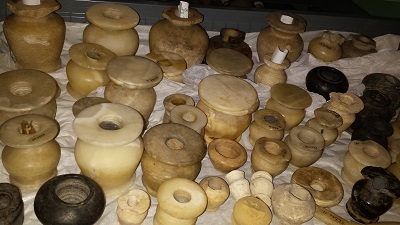Lead carbonate is one of the main compounds in art and archaeology, used as an ingredient in paint and cosmetics since ancient times. Carbon-14 (radiocarbon) dating by accelerator mass spectrometry is usually carried out on organic remains — wood, charcoal, bone, etc. — into which radioactive carbon is incorporated by photosynthesis or ingestion.
On 28 June 2018, in Communications Chemistry, a team from the Laboratory for the Measurement of Carbon-14 (*) in association with the Louvre (**) is publishing the results of the very first measurement of carbon-14 in lead carbonates. The technique has never been used until now on this type of compound. The development of this measurement technique constitutes the main novelty of the study.
Radiocarbon measurement applied to ancient cosmetics
A further novelty is the fact that the technique has been used on samples dating from antiquity. It provides direct proof for a theory (advanced by chemists two decades ago) that the Ancient Egyptians already had chemical synthesis techniques and used them in their cosmetics 'industry'.
Whether powdered make-up is natural or man-made can be identified by means of radiocarbon. Radiocarbon is produced by nuclear reactions in the upper atmosphere, then assimilated by living organisms in the form of carbon dioxide; because of its gradual decay, carbon-14 is not present in minerals formed a very long time ago (see inset). So cosmetics that have undergone only minimal preparation (e.g. crushing) contain no traces of carbon-14 because they come from the mineral world. However, radiocarbon can be present in products prepared using chemistry because of the incorporation of contemporary CO2 from compounds in the biosphere (organic inputs).
► The study demonstrates that cerussite (PbCO3) was first used for Ancient Egyptian cosmetics in its natural mineral state — without traces of radiocarbon — and, later on, in the form of a synthetic compound manufactured by the Ancient Greeks.
► The study also shows that phosgenite (PbCl2(CO3)2) was produced artificially by the Egyptians approximately 3500 years ago.
► These results confirm the expertise of the Ancient Egyptians and Greeks in the chemical synthesis of cosmetics.
The detection of radiocarbon in lead carbonate is very promising for the history of art and provides a new tool for the authentication of paintings by dating white lead, which is widely found, among other things, in Renaissance paintings.

Rouge pots from Ancient Egypt (Collection of the Louvre, Paris) from which some of the samples were taken (c) LMC14/C. Moreau
Carbon-14, from formation to decay
Carbon-14, or radiocarbon, is a radioactive carbon isotope. Its radioactive half-life, which is the time taken for half of its atoms to decay to nitrogen-14, is 5,730 years.
It is constantly generated in the atmosphere: the interaction of cosmic radiation with atoms in the upper atmosphere (especially oxygen) produces neutrons, which are absorbed by nitrogen atoms, turning them into carbon-14 atoms.
When it oxidises in the atmosphere, carbon-14 forms CO2. Plants incorporate the carbon-14 via CO2, passing it on to all living things through the food chain. When an organism dies, all exchanges with its environment cease and it stops incorporating any more carbon-14. Its carbon-14 is not renewed and gradually disintegrates: its radioactive decay begins. Most minerals taken from the ground contain no traces of carbon-14 because its radioactive half-life is only 5,730 years, which is tiny compared to the geological era of their formation.

Accelerometer mass spectrometry at LMC14 used to date the cosmetics (c) CEA/L. Godart
(*) The Laboratory for the Measurement of Carbon-14 (LMC14), in Paris-Saclay, conducts carbon-14 measurements for the scientific community in France. It is run by the CEA, CNRS, IRSN, the Ministry of Culture and IRD. Its activities are based on two sites: samples are prepared on the CNRS campus at Gif-sur-Yvette, and the production of carbon targets and measurement of 14C by accelerator mass spectrometry (SMA ARTEMIS) take place at CEA Saclay. LMC14 is run by the Laboratory of Climate and Environmental Sciences (LSCE, CEA/CNRS/UVSQ, Paris-Saclay)
(**) Departments of Egyptian Antiquities and Greek, Etruscan and Roman Antiquities at the Louvre, Paris.